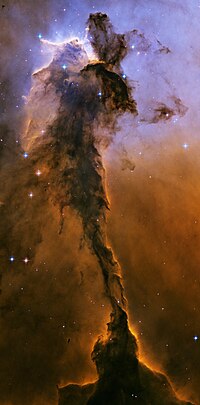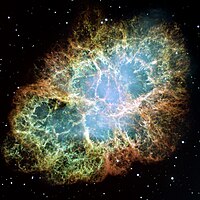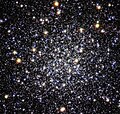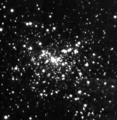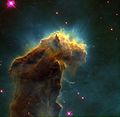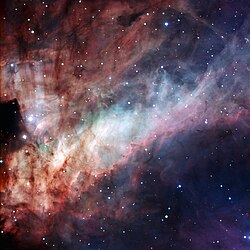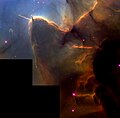Messier Index/Print Version/1
Introduction
The Messier objects are a set of astronomical objects first listed by French astronomer Charles Messier in his "Catalogue des Nébuleuses et des Amas d'Étoiles" ("Catalogue of Nebulae and Star Clusters") included in the Connaissance des Temps for 1774 (published in 1771). The original motivation of the catalogue was that Messier was a comet hunter, and was frustrated by objects which resembled but were not comets. He therefore compiled a list of these objects,[1] in collaboration with his assistant Pierre Méchain.
The first edition covered 45 objects numbered M1 to M45. The total list published by Messier finally contained 103 objects, but the list "got an independent life" by successive additions by other astronomers, motivated by side notes in Messier's and Mechain's texts indicating that either of them knew of the objects. The first such addition came from Camille Flammarion in 1921, who added M104 after finding Messiers side note in his 1781 edition exemplar of the catalogue. M105 to M107 were added by Helen Sawyer Hogg in 1947, M108 and M109 by Owen Gingerich in 1960, and M110 by Kenneth Glyn Jones.[2] M102 was observed by Méchain, who communicated his notes to Messier; later, it was noted by Méchain himself that this object does not exist, and it was simply a re-observation of M101. Some sources mention the galaxy NGC 5866 as an identification for M102, but its description does not fit with Méchain's notes.
Messier's final catalogue was included in the Connaissance des Temps for 1784 (published in 1781).[3] These objects are still known by their Messier number from this list.
Because Messier lived and did his astronomical work in France in the Northern Hemisphere, the list he compiled contains only objects from the north celestial pole to a celestial latitude of about –35.7°. Many impressive Southern objects, such as the Large and Small Magellanic Clouds are excluded from the list.
All of the Messier objects are visible with binoculars or small telescopes (under favorable conditions); therefore they are popular viewing objects for amateur astronomers. In early spring, astronomers sometimes gather for "Messier marathons", when all of the objects can be viewed over a single night.[4]
A summary of the astrophysics of each Messier object, as well as all of the objects in the Herschel 400 Catalog, can be found in Concise Catalog of Deep-sky Objects: Astrophysical Information for 500 Galaxies, Clusters and Nebulae by W. H. Finlay, ISBN 1-85233-691-9.
References
|
External links |
M1
| Crab Nebula | |
|---|---|
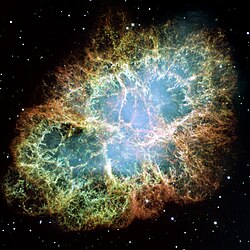 M1, the Crab Nebula. Courtesy of NASA/ESA | |
| Observation data: J2000.0 epoch | |
| Type | Supernova Remnant |
| Right ascension | 05h 34m 31.97s[1] |
| Declination | +22° 00′ 52.1″[1] |
| Distance | 6.5 ± 1.6 kly (2.0 ± 0.5 kpc)[2] |
| Apparent magnitude (V) | +8.4 |
| Apparent dimensions (V) | 420″ × 290″[3]a |
| Constellation | Taurus |
| Physical characteristics | |
| Radius | 5.5 ly (1.7 pc) [4] |
| Absolute magnitude (V) | -3.1 ± 0.5b |
| Notable features | Optical pulsar |
| Other designations | M1,[1] NGC 1952[1], Sharpless 244 |
The Crab Nebula (catalogue designations M1, NGC 1952, Taurus A) is a supernova remnant and pulsar wind nebula in the constellation of Taurus. The nebula was first observed by John Bevis in 1731, and corresponds to a bright supernova recorded by Chinese and Arab astronomers in 1054. It is said that it was visible during the day for months, and remained visible at night for several years.
At X-ray and gamma-ray energies above 30 KeV, the Crab is generally the strongest persistent source in the sky, with measured flux extending to above 1012 eV. Located at a distance of about 6,500 light-years (2 kpc) from Earth, the nebula has a diameter of 11 light-years (3.4 pc) and expands at a rate of about 1,500 kilometers per second.
At the center of the nebula lies the Crab Pulsar, a rotating neutron star, which emits pulses of radiation from gamma-rays to radio waves with a spin rate of 30.2 times per second. The nebula was the first astronomical object identified with a historical supernova explosion.
The nebula acts as a source of radiation for studying celestial bodies that occult it. In the 1950s and 1960s, the Sun's corona was mapped from observations of the Crab's radio waves passing through it, and more recently, the thickness of the atmosphere of Saturn's moon Titan was measured as it blocked out X-rays from the nebula.
External links
- Data on the Crab Nebula, on a supernova remnants catalogue managed by David A. Green (University of Cambridge)
- The Crab Nebula at ESA/Hubble
- Messier 1, SEDS Messier pages
- Images of the Crab from the Chandra X-ray Observatory
- Chandra page about the nebula
- Images of the Crab from the Hubble Space Telescope
- Lord Rosse's drawings of M1, the Crab Nebula from SEDS
- NightSkyInfo.com - M1, the Crab Nebula
- M1 The Crab Nebula
- Slooh Video Podcast on M1
- M1 The Crab Pulsar in Crab Nebula / Video
</noinclude>
M2
| M2 | |
|---|---|
 | |
| Observation data (J2000 epoch) | |
| Class | II |
| Constellation | Aquarius |
| Right ascension | 21h 33m 27s[1] |
| Declination | -00° 49′ 24″[1] |
| Distance | 37.5 kly (11.5 kpc) |
| Apparent magnitude (V) | +6.3[1] |
| Apparent dimensions (V) | 16′.0 |
| Physical characteristics | |
| Mass | kg ( M) |
| Radius | 87.3 ly [5] |
| Estimated age | 13 Gyr |
| Other designations | NGC 7089[1] |
Messier 2 or M2 (also designated NGC 7089) is a globular cluster in the constellation Aquarius, five degrees north of the star Beta Aquarii. It contains about 150,000 stars, including 21 known variable stars. Its brightest stars are red and yellow giants. The overall spectral type is F4.
Under extremely good conditions, it is just visible to the naked eye. Binoculars or small telescopes will identify this cluster as non-stellar, while larger telescopes will resolve individual stars, of which the brightest are of apparent magnitude 13.1. It is about 37,500 light-years away from Earth. At 175 light-years in diameter, it is one of the larger globular clusters known. The cluster is rich and compact.
M2 was discovered by the French astronomer Jean-Dominique Maraldi in 1746 while observing a comet with Jacques Cassini. Charles Messier rediscovered it in 1760 but thought it a nebula without any stars associated with it. William Herschel was the first to resolve individual stars in the cluster, in 1794.

M3
| NGC 5272 | |
|---|---|
 | |
| Observation data (J2000 epoch) | |
| Class | VI |
| Constellation | Canes Venatici |
| Right ascension | 13h 42m 11.23s[1] |
| Declination | 28° 22′ 31.6″[1] |
| Distance | 33.9 kly (10.4 kpc) |
| Apparent magnitude (V) | +6.2[1] |
| Apparent dimensions (V) | 18′.0 |
| Physical characteristics | |
| Mass | 4.87 x 1035 kg kg (245 000 M) |
| Radius | 90 ly |
| VHB | - |
| Estimated age | 8 x 109 years |
| Notable features | - |
| Other designations | NGC 5272[1] |
Messier 3 (also known as M3 or NGC 5272) is a globular cluster in the constellation Canes Venatici. It was discovered by Charles Messier in 1764, and resolved into stars by William Herschel around 1784. This cluster is one of the largest and brightest, and is made up of around 500,000 stars. It is located at a distance of about 33,900 light-years away from Earth. M3 has an apparent magnitude of 6.2, making it visible to the naked eye under dark conditions. From a moderate-sized telescope, the cluster is fully defined.
M4
| M4 | |
|---|---|
 | |
| Observation data (J2000 epoch) | |
| Class | IX |
| Constellation | Scorpius |
| Right ascension | 16h 23m 35.41s[1] |
| Declination | -26° 31′ 31.9″[1] |
| Distance | 7.2 kly (2.2 kpc) |
| Apparent magnitude (V) | +7.12[1] |
| Apparent dimensions (V) | 36′.0 |
| Physical characteristics | |
| Mass | kg ( M) |
| Radius | 35 light years |
| Estimated age | 13 billion years |
| Notable features | 1°.3 west of Antares |
| Other designations | NGC 6121[1] |
Messier 4 or M4 (also designated NGC 6121) is a globular cluster in the constellation of Scorpius. It was discovered by Philippe Loys de Chéseaux in 1746 and catalogued by Charles Messier in 1764. It was the first globular cluster in which individual stars were resolved.

Visibility
M4 is conspicuous in even the smallest of telescopes as a fuzzy ball of light. It appears about the same size as the Moon in the sky. It is one of the easiest globular clusters to find, being located only 1.3 degrees west of the bright star Antares, with both objects being visible in a wide field telescope. Modestly sized telescopes will begin to resolve individual stars of which the brightest in M4 are of apparent magnitude 10.8.
Characteristics
M4 is a rather loosely concentrated cluster of class IX and measures 75 light years across. It features a characteristic "bar" structure across its core, visible to moderate sized telescopes. The structure consists of 11th magnitude stars and is approximately 2.5' long and was first noted by William Herschel in 1783. At least 43 variable stars have been observed within M4.
M4 is approximately 7,200 light years away, the same distance as NGC 6397, making these the two closest globular clusters to our Solar System.
Notable stars

Photographs taken with the Hubble Space Telescope in 1995 have revealed white dwarf stars in M4 that are among the oldest known stars in the Milky Way Galaxy at an age of 13 billion years. One such white dwarf has been found to be a binary star with a pulsar companion, PSR B1620-26 and a planet orbiting it with a mass of 2.5 times that of Jupiter.
In 1987 a millisecond pulsar was discovered in M4 with a period of 3.0 milliseconds or about ten times faster than the Crab Pulsar.
M5
| M5 | |
|---|---|
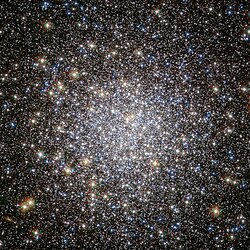 | |
| Observation data (J2000 epoch) | |
| Class | V |
| Constellation | Serpens |
| Right ascension | 15h 18m 33.75s[1] |
| Declination | +02° 04′ 57.7″[1] |
| Distance | 24.5 kly (7.5 kpc) |
| Apparent magnitude (V) | +6.65[1] |
| Apparent dimensions (V) | 23′.0 |
| Physical characteristics | |
| Mass | kg ( M) |
| Radius | 80 ly |
| Estimated age | 13 Gyr |
| Other designations | NGC 5904[1] |
Messier 5 or M5 (also designated NGC 5904) is a globular cluster in the constellation Serpens. It was discovered by Gottfried Kirch in 1702. It should not be confused with the much fainter and more distant globular cluster Palomar 5, which is situated nearby in the sky.
Discovery and visibility
M5 is, under extremely good conditions, just visible to the naked eye as a faint "star" near the star 5 Serpentis. Binoculars or small telescopes will identify the object as non-stellar while larger telescopes will show some individual stars, of which the brightest are of apparent magnitude 12.2.
M5 was discovered by the German astronomer Gottfried Kirch in 1702 when he was observing a comet. Charles Messier also noted it in 1764, but thought it a nebula without any stars associated with it. William Herschel was the first to resolve individual stars in the cluster in 1791, counting roughly 200.
Characteristics

Spanning 165 light-years in diameter, M5 is one of the larger globular clusters known. The gravitational sphere of influence of M5, (ie. the volume of space in which stars are gravitationally bound to it rather than being torn away by the Milky Way's gravitational pull) has a radius of some 200 light-years.
At 13 billion years old it, M5 is also one of the older globulars associated with the Milky Way Galaxy. Its distance is about 24,500 light-years from Earth and the cluster contains more than 100,000 stars, as many as 500,000 according to some estimates.
Notable stars
kalpak stars in M5 are known to be variable in brightness, 97 of them belonging to the RR Lyrae type. RR Lyrae stars, sometimes referred to as "Cluster Variables", are somewhat similar to Cepheid type variables and as such can be used as a tool to measure distances in outer space since the relation between their luminosities and periods are well known. The brightest and most easily observed variable in M5 varies from magnitude 10.6 to 12.1 in a period of just under 26.5 days.
A dwarf nova has also been observed in this cluster.
External links
- SIMBAD: M5
- M5,SEDS Messier pages
- M5, Galactic Globular Clusters Database page
- Historic observations of M5
- Image of M5 by Waid Observatory
References
- ↑ a b c d e f g h i j k l m n o p q r s t "SIMBAD Astronomical Database". Results for NGC 1952. Retrieved 2006-12-25. Invalid
<ref>tag; name "simbad" defined multiple times with different content - ↑ Kaplan, D. L.; Chatterjee, S.; Gaensler, B. M.; Anderson, J. (2008), "A Precise Proper Motion for the Crab Pulsar, and the Difficulty of Testing Spin-Kick Alignment for Young Neutron Stars", Accepted for publication in the Astrophysical Journal, 677: 1201, doi:10.1086/529026
- ↑ Invalid
<ref>tag; no text was provided for refs namedTrimble1973 - ↑ Carroll, Bradley W.; Ostlie, Dale A., An Introduction to Modern Astrophysics, Second Edition
- ↑ distance × sin( diameter_angle / 2 ) = 87.3 ly. radius
M6
| Butterfly Cluster | |
|---|---|
 | |
| Observation data (J2000.0 epoch) | |
| Constellation | Scorpius |
| Right ascension | 17h 40.1m |
| Declination | −32° 13′ |
| Distance | 1.6 kly (491 Pc) |
| Apparent magnitude (V) | 4.2 |
| Apparent dimensions (V) | 25′ |
| Other designations | Messier 6, NGC 6405, Collinder 341, Melotte 178, Lund 769, OCL 1030, ESO 455-SC030 |
The Butterfly Cluster (cataloged as Messier 6 or M6, and as NGC 6405) is an w:open cluster of w:stars in the constellation of w:Scorpius. Its name derives from the vague resemblance of its shape to a w:butterfly.
The first astronomer to record the Butterfly Cluster's existence was w:Giovanni Battista Hodierna in 1654. However, w:Robert Burnham, Jr has proposed that the 1st century astronomer w:Ptolemy may have seen it with the naked eye while observing its neighbor the w:Ptolemy Cluster (M7). w:Charles Messier catalogued the cluster as M6 in 1764. It was not till the 20th century that star counts, distance, and other properties were measured.
Characteristics
Most of the bright stars in this cluster are hot, blue B type stars but the brightest member is a w:K type orange w:giant star, BM Scorpii, which contrasts sharply with its blue neighbours in photographs. BM Scorpii, is classed as a semiregular w:variable star, its brightness varying from magnitude +5.5 to magnitude +7.0.
Estimates of the Butterfly Cluster's distance have varied over the years, with a mean value of around 1,600 w:light years, giving it a spatial dimension of some 12 light years. Modern measurements show its total visual brightness to be magnitude 4.2.
External links
M7
| M7 | |
|---|---|
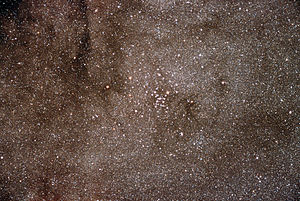 | |
| Observation data (J2000.0 epoch) | |
| Constellation | Scorpius |
| Right ascension | 17h 53.9m |
| Declination | −34° 49′ |
| Distance | 0.8 kly (245 Pc) |
| Apparent magnitude (V) | 3.3 |
| Apparent dimensions (V) | 80.0′ |
| Other designations | NGC 6475, Ptolemy Cluster |
Messier 7 or M7, also designated NGC 6475 and sometimes known as the Ptolemy Cluster, is an w:open cluster of w:stars in the w:constellation of w:Scorpius.
The cluster is easily detectable with the w:naked eye, close to the "stinger" of Scorpius. It has been known since w:antiquity; it was first recorded by the 1st-century astronomer w:Ptolemy, who described it as a w:nebula in 130 AD. w:Giovanni Batista Hodierna observed it before 1654 and counted 30 stars in it. w:Charles Messier catalogued the cluster in 1764 and subsequently included it in his list of w:comet-like objects as 'M7'.
Telescopic observations of the cluster reveal about 80 stars within a field of view of 1.3° across. At the cluster's estimated distance of 800–1000 w:light years this corresponds to an actual diameter of 18–25 light years. The age of the cluster is around 220 million years while the brightest star is of magnitude 5.6.
External links
M8
| Lagoon Nebula | |
|---|---|
 M8, the Lagoon Nebula Courtesy Hunter Wilson | |
| Observation data: J2000 epoch | |
| Type | Emission |
| Right ascension | 18h 03m 37s[1] |
| Declination | −24° 23′ 12″[1] |
| Distance | 4,100 ly (1,250 pc)[2] |
| Apparent magnitude (V) | 6.0 |
| Apparent dimensions (V) | 90 × 40 arcmins |
| Constellation | Sagittarius |
| Physical characteristics | |
| Radius | 55 × 20 ly |
| Absolute magnitude (V) | ??? |
| Notable features | — |
| Other designations | Sharpless 25, RCW 146, Gum 72 M8 contains: NGC 6523, NGC 6530[1], Hourglass nebula[3] |
The Lagoon Nebula (catalogued as Messier 8 or M8, and as NGC 6523) is a giant w:interstellar cloud in the w:constellation Sagittarius. It is classified as an w:emission nebula and as an w:H II region.
The Lagoon Nebula was discovered by w:Guillaume Le Gentil in 1747 and is one of only two star-forming w:nebulae faintly visible to the naked eye from mid-northern latitudes. Seen with w:binoculars, it appears as a distinct w:oval cloudlike patch with a definite core. A fragile w:star cluster appears superimposed on it.
Characteristics
The Lagoon Nebula is estimated to be 4,100 w:light-years from the Earth. In the sky of Earth, it spans 90' by 40', translates to an actual dimension of 110 by 50 light years. Like many nebulas, it appears w:pink in time-exposure color photos but is gray to the eye peering through w:binoculars or a w:telescope, w:human vision having poor color sensitivity at low light levels.
The nebula contains a number of w:Bok globules - dark, collapsing clouds of protostellar material - the most prominent of which have been catalogued by E. E. Barnard as B88, B89 and B296. It also includes a funnel-like or w:tornado-like structure caused by a hot O-type star that pours out w:ultraviolet light, heating and ionizing gases on the surface of the nebula.
left|thumb|Central region of the Lagoon Nebula, showing the Hourglass Nebula to the right
The Lagoon Nebula also contains at its centre a structure known as the "Hourglass Nebula" (so named by w:John Herschel), which should not be confused with the better known w:Hourglass Nebula in the constellation of w:Musca. In 2006 the first four w:Herbig-Haro objects were detected within the Hourglass, also including w:HH 870. This provides the first direct evidence of active star formation by accretion within it.[2]
References
- ↑ a b c "SIMBAD Astronomical Database". Results for M8. Retrieved 2006-11-15.
- ↑ a b Arias, J. I.; Barbá, R. H.; Maíz Apellániz, J.; Morrell, N. I.; Rubio, M. (2006). "The infrared Hourglass cluster in M8". Monthly Notices of the Royal Astronomical Society. 366 (3): 739–757. doi:10.1111/j.1365-2966.2005.09829.x.
{{cite journal}}: CS1 maint: multiple names: authors list (link) - ↑ "SIMBAD Astronomical Database". Results for Hourglass Nebula. Retrieved 2006-12-22.
External links
- Messier 8, SEDS Messier pages
- NightSkyInfo.com - M8, the Lagoon Nebula
- Messier 8, Pete's Astrophotography Gallery
- Astronomy Picture of the Day (APOD): Lagoon Nebula [1]
M9
| M9 | |
|---|---|
 Messier 9, from 2MASS | |
| Observation data (J2000 epoch) | |
| Class | VIII |
| Constellation | Ophiuchus |
| Right ascension | 17h 19m 11.78s[1] |
| Declination | -18° 30′ 58.5″[1] |
| Distance | 25.8 kly (7.9 kpc) |
| Apparent magnitude (V) | +8.42[1] |
| Apparent dimensions (V) | 12′.0 |
| Physical characteristics | |
| Mass | kg ( M) |
| Radius | 45 ly |
| Other designations | NGC 6333[1] |
Messier 9 or M9 (also designated NGC 6333) is a w:globular cluster in the w:constellation of w:Ophiuchus. It was discovered by w:Charles Messier in w:1764.
M9 is one of the nearer globular clusters to the center of the w:Milky Way Galaxy with a distance of around 5,500 w:light-years. Its distance from w:Earth is 25,800 light-years.
The total w:luminosity of this cluster is around 120,000 times that of the w:Sun, the w:absolute magnitude being -8.04. The brightest individual w:stars in M9 are of w:apparent magnitude 13.5, making them visible in moderately sized w:telescopes. There have been 13 w:variable stars found in M9.
Nearby, at about 80' to the northeast of M9 is the dimmer globular cluster w:NGC 6356, while at about 80' to the southeast is the globular w:NGC 6342.
External links
References
- ↑ a b c d "SIMBAD Astronomical Database". Results for NGC 6333. Retrieved 2006-11-15.
M10

| M10 | |
|---|---|
 | |
| Observation data (J2000 epoch) | |
| Class | VII |
| Constellation | Ophiuchus |
| Right ascension | 16h 57m 08.99s[1] |
| Declination | -04° 05′ 57.6″[1] |
| Distance | 14.3 kly (4.4 kpc) |
| Apparent magnitude (V) | 6.4[1] |
| Apparent dimensions (V) | 20′.0 |
| Physical characteristics | |
| Mass | kg ( M) |
| Radius | 41.6 ly [2] |
| Other designations | NGC 6254[1] |
Messier 10 or M10 (also designated NGC 6254) is a w:globular cluster in the w:constellation of w:Ophiuchus.
The object was discovered by w:Charles Messier on w:May 29 w:1764, who cataloged it as number 10 in his list. He described it as a "w:nebula without stars", but later study revealed it as a globular cluster of thousands of stars.
M10 has an apparent diameter of some 20 w:arcminutes, about two-thirds of the w:apparent diameter of the w:Moon. Viewed through medium-sized w:telescopes it appears about half that size (8' to 9'), as its bright core is only 35 light-years across. M10 has a spatial w:diameter of 83 w:light-years and is estimated to be 14,300 light-years away from Earth. Four w:variable stars have been discovered in this cluster.
External links
References
M11
| Wild Duck Cluster | |
|---|---|
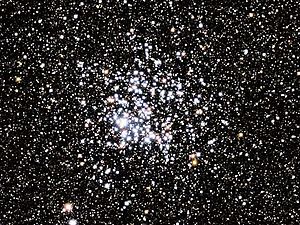 The Wild Duck Cluster (M11-NGC 6705) | |
| Observation data (J2000.0 epoch) | |
| Constellation | Scutum |
| Right ascension | 18h 51.1m |
| Declination | −06° 16′ |
| Distance | 6,200 ly (1,900 pc) |
| Apparent magnitude (V) | 6.3 |
| Apparent dimensions (V) | 14.0′ |
| Other designations | Messier 11, NGC 6705 |
The Wild Duck Cluster (also known as Messier 11, or NGC 6705) is an w:open cluster in the w:constellation w:Scutum. It was discovered by w:Gottfried Kirch in 1681. w:Charles Messier included it in his catalogue in 1764.
The Wild Duck Cluster is one of the richest and most compact of the known open clusters, containing about 2900 w:stars. Its age has been estimated to about 220 million years. Its name derives from the brighter stars forming a triangle which could represent a flying flock of w:ducks.
External links
M12
| M12 | |
|---|---|
 Messier 12, from 2MASS | |
| Observation data (J2000 epoch) | |
| Class | IX |
| Constellation | Ophiuchus |
| Right ascension | 16h 47m 14.52s[1] |
| Declination | -01° 56′ 52.1″[1] |
| Distance | 16.0 kly (4.9 kpc) |
| Apparent magnitude (V) | +7.68[1] |
| Apparent dimensions (V) | 16′.0 |
| Physical characteristics | |
| Mass | kg ( M) |
| Radius | 37.2 ly[2] |
| Other designations | NGC 6218[1] |
Messier 12 or M 12 (also designated NGC 6218) is a w:globular cluster in the w:constellation of w:Ophiuchus. It was discovered by w:Charles Messier on w:May 30, w:1764.
Located roughly 3° in the sky from the cluster M10, M12 is about 16,000 w:light-years from Earth and has a spatial diameter of about 75 light-years. The brightest stars of M12 are of 12th magnitude. It is rather loosely packed for a globular and was once thought to be a tightly concentrated w:open cluster. Thirteen w:variable stars have been recorded in this cluster.
A study published in w:2006 concluded that this cluster has an unusually low number of low mass stars. The authors surmise that they were stripped from the cluster by the gravitational influence of the w:Milky Way.[2]
-
M12 core by HST, 3.18′ view
-
M12, courtesy Hunter Wilson
-
The Central Part of Messier 12. Credit: w:ESO
External links
- Messier 12, SEDS Messier pages
- Messier 12, Galactic Globular Clusters Database page
- 'Stolen' stars article at Universe Today
References
M13
| M13 | |
|---|---|
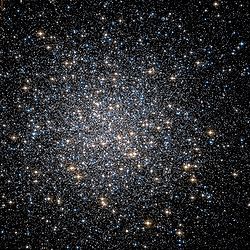 | |
| Observation data (J2000 epoch) | |
| Class | V |
| Constellation | Hercules |
| Right ascension | 16h 41m 41.44s[1] |
| Declination | +36° 27′ 36.9″[1] |
| Distance | 25.1 kly () |
| Apparent magnitude (V) | +5.8[1] |
| Apparent dimensions (V) | 23′ |
| Physical characteristics | |
| Mass | 1036 kg (6×105 [2] M) |
| Radius | 84 ly[3] |
| Estimated age | 1.4×1010 yr |
| Notable features | one of the best well-known clusters of the northern hemisphere |
| Other designations | NGC 6205[1] |
Messier 13 or M13 (also designated NGC 6205 and sometimes called the Great Globular Cluster in Hercules or the Hercules Globular Cluster) is a w:globular cluster in the w:constellation of Hercules.
Discovery and visibility
M13 was discovered by w:Edmond Halley in 1714, and catalogued by w:Charles Messier on June 1, 1764.
It is located at w:right ascension 16h 41.7m and w:declination +36° 28'. With an w:apparent magnitude of 5.8, it is barely visible with the w:naked eye on a very clear night. Its diameter is about 23 arc minutes and it is readily viewable in small telescopes. Nearby is w:NGC 6207, a 12th magnitude edge-on galaxy that lies 28 arc minutes directly north east. A small galaxy, IC 4617, lies halfway between NGC 6207 and M13, north-northeast of the large globular's center.
Characteristics
M13 is about 145 light-years in w:diameter, and it is composed of several hundred thousand w:stars, the brightest of which is the w:variable star V11 with an apparent magnitude of 11.95. M13 is 25,100 light-years away from w:Earth.
Arecibo message
The w:Arecibo message of 1974, designed to communicate the existence of human life to hypothetical extraterrestrials, was transmitted toward M13. The reason was that with a higher star density, the chances of a life harboring planet with intelligent life forms, were higher.
Literary references
- The w:science fiction novellas "w:Sucker Bait" by w:Isaac Asimov and "w:Question and Answer" by w:Poul Anderson take place on Troas, a world within M13.
- In the science fiction series w:Perry Rhodan, M13 is the location of Arkon, the home world of the race of Arkonides.
- In author Dan Simmon's w:Hyperion Cantos the Hercules cluster is where Earth was secretly moved to after it was supposedly destroyed.
- In w:The Sirens of Titan, w:Kurt Vonnegut writes "Every passing hour brings the Solar System forty-three thousand miles closer to Globular Cluster M13 in Hercules -- and still there are some misfits who insist that there is no such thing as progress."

External links
- Messier 13, SEDS Messier pages
- Messier 13, Galactic Globular Clusters Database page
- Messier 13, High-resolution LRGB image based on 2 hrs total exposure
- Messier 13, Image by Waid Observatory
- NightSkyInfo.com - M13, the Hercules Globular Cluster
- Photometric study of the V2 cepheid in M13
- Period, Amplitude and Light Curve of V38 in M13
- Great Globular Cluster in Hercules (Messier 13/NGC 6205)
- M13 images taken by Stargazer-Observatory
- M13
References
- ↑ a b c d "SIMBAD Astronomical Database". Results for NGC 6205. Retrieved 2006-11-15.
- ↑ Leonard, Peter J. T.; Richer, Harvey B.; Fahlman, Gregory G. "The mass and stellar content of the globular cluster M13".
{{cite web}}: CS1 maint: multiple names: authors list (link) - ↑ distance × sin( diameter_angle / 2 ) = 84 ly. radius
M14
| M14 | |
|---|---|
 Messier 14, from 2MASS | |
| Observation data (J2000 epoch) | |
| Class | VIII |
| Constellation | Ophiuchus |
| Right ascension | 17h 37m 36.15s[1] |
| Declination | -03° 14′ 45.3″[1] |
| Distance | 30.3 kly (9.3 kpc) |
| Apparent magnitude (V) | +8.32[1] |
| Apparent dimensions (V) | 11.0′ |
| Physical characteristics | |
| Mass | - kg (- M) |
| Radius | 50 ly[2] |
| VHB | - |
| Estimated age | - |
| Notable features | - |
| Other designations | NGC 6402[1] |
Messier 14 (also known as M14 or NGC 6402) is a w:globular cluster in the w:constellation w:Ophiuchus. It was discovered by w:Charles Messier in w:1764.
At a distance of about 30,000 light-years, M14 contains several hundreds of thousands of w:stars. At an w:apparent magnitude +7.6 it can be easily observed with w:binoculars. Medium-sized w:telescopes will show some hint of the individual stars of which the brightest is of magnitude +14.
The total w:luminosity of M14 is in the order of 400,000 times that of the w:Sun corresponding to an w:absolute magnitude of -9.12. The shape of the cluster is decidedly elongated. M14 is about 100 light-years across.
A respectable total of 70 w:variable stars is known in M14, many of the W Virginis variety common in globular clusters. In w:1938, a w:nova appeared although this was not discovered until w:photographic plates from that time were studied in w:1964. It is estimated that the nova reached a maximum brightness of magnitude +9.2, over five times brighter than the brightest 'normal' star in the cluster.
Slightly over 3° southwest of M14 lies the faint globular cluster NGC 6366.

External links
References
M15
| M15 | |
|---|---|
 M15 photographed by Hubble Space Telescope. The planetary nebula Pease 1 can be seen as a fuzzy reddish object near the upper left of this image. | |
| Observation data (J2000 epoch) | |
| Class | IV |
| Constellation | Pegasus |
| Right ascension | 21h 29m 58.38s[1] |
| Declination | +12° 10′ 00.6″[1] |
| Distance | 33.6 kly (10.3 kpc) |
| Apparent magnitude (V) | +6.2 |
| Apparent dimensions (V) | 18′.0 |
| Physical characteristics | |
| Mass | - kg (- M) |
| Radius | ~88 ly[2] |
| VHB | 15.83 |
| Estimated age | - |
| Notable features | steep central cusp |
| Other designations | NGC 7078, GCl 120[1] |
Messier 15 or M15 (also designated NGC 7078) is a w:globular cluster in the w:constellation Pegasus. It was discovered by w:Jean-Dominique Maraldi in w:1746 and included in w:Charles Messier's catalogue of w:comet-like objects in w:1764. At an estimated 13.2 billion years old, it is one of the oldest known globular clusters.
M15 is about 33,600 w:light-years from w:Earth. It has an w:absolute magnitude of -9.2 which translates to a total w:luminosity of 360,000 times that of the w:Sun. Messier 15 is one of the most densely packed globulars known in the w:Milky Way galaxy. Its core has undergone a contraction known as 'w:core collapse' and it has a central density cusp with an enormous number of stars surrounding what may be a central black hole.
Messier 15 contains 112 w:variable stars, a rather high number. It also contains at least 8 w:pulsars, including one double w:neutron star system, M15 C. Moreover, M15 houses w:Pease 1, one of only four w:planetary nebulae known to reside within a globular cluster, which was discovered in w:1928.[3]
To the amateur w:astronomer Messier 15 appears as a fuzzy star in the smallest of w:telescopes. Mid to large size telescopes (at least 6 in./150 mm diameter) will start to reveal individual stars, the brightest of which are of magnitude +12.6.
-
The central square arcminute of M15 imaged using the w:lucky imaging technique
-
Messier 15 Amateur Image Courtesy Hunter Wilson
External links
- Messier 15, SEDS Messier pages
- Messier 15, Galactic Globular Clusters Database page
- Globular Cluster Photometry With the Hubble Space Telescope. V. WFPC Study of M15's Central density Cusp
- Wikisky.org SDSS image of M15
References
- ↑ a b c "SIMBAD Astronomical Database". Results for NGC 7078. Retrieved 2006-11-16.
- ↑ distance × sin( diameter_angle / 2 ) = 88 ly. radius
M16
| Eagle Nebula | |
|---|---|
 | |
| Observation data: J2000.0 epoch | |
| Type | Emission |
| Right ascension | 18h 18m 48s[1] |
| Declination | -13° 49′[1] |
| Distance | 7,000 ly |
| Apparent magnitude (V) | +6.0[1] |
| Apparent dimensions (V) | 7.0arcmins |
| Constellation | Serpens |
| Physical characteristics | |
| Radius | 70×55 ly (cluster 15 ly) |
| Absolute magnitude (V) | -8.21 |
| Notable features | 5.5 million years old |
| Other designations | Messier 16, NGC 6611,[1], Sharpless 49, RCW 165, Gum 83 |
The Eagle Nebula (catalogued as Messier 16 or M16, and as NGC 6611) is a young w:open cluster of w:stars in the w:constellation w:Serpens, discovered by w:Jean-Philippe de Cheseaux in 1745-46. Its name derives from its shape which is reminiscent of an w:eagle. It is the subject of a famous photograph by the w:Hubble Space Telescope, which shows pillars of star-forming gas and dust within the nebula.
Characteristics
The Eagle Nebula is part of a diffuse w:emission nebula, or H II region, which is catalogued as w:IC 4703. This region of active current star formation is about 6,500 w:light-years distant. The tower of gas that can be seen coming off the nebula is approximately 57 trillion miles (97 trillion km) high.
The brightest star in the nebula has an w:apparent magnitude of +8.24, easily visible with good binoculars.
'Pillars of Creation' region

Images made in 1995 by Jeff Hester and Paul Scowen using the w:Hubble Space Telescope greatly improved scientific understanding of processes inside the nebula. One of these, a famous photograph known as the "w:Pillars of Creation", depicts a large region of star formation. Its small dark areas are believed to be w:protostars. The pillar structure of the region resembles that of a much larger star formation region, imaged with the w:Spitzer Space Telescope in 2005, in Cassiopeia, which is designated W5 and has been dubbed the "Mountains of Creation".[2]
Combinations of w:X-ray images from the Chandra observatory with Hubble's "Pillars" image have shown that X-ray sources (from young stars) do not coincide with the pillars, but instead randomly dot the area.[4] This suggests that star formation may have peaked approximately one million years ago in the Eagle Nebula and any protostars in the pillar's EGGs are not yet hot enough to emit X-rays.[citation needed]
In early 2007, scientists using the Spitzer discovered evidence that potentially indicates the Pillars were destroyed by a nearby w:supernova explosion about 6,000 years ago, but the light showing the new shape of the nebula will not reach w:Earth for another millennium.[3]
In fiction
-
An infrared view of the pillars reveals different structures. Credit w:ESO
-
Three-colour composite mosaic image of the Eagle Nebula. Credit w:ESO
External links
References
- ↑ a b c d "SIMBAD Astronomical Database". Results for NGC 6611. Retrieved 2006-11-16.
- ↑ Spitzer Captures Cosmic "Mountains Of Creation"
- ↑ Famous Space Pillars Feel the Heat of Star's Explosion - Jet Propulsion Laboratory
M17
| Omega Nebula | |
|---|---|
 | |
| Observation data: w:J2000 epoch | |
| Type | Emission |
| Right ascension | 18h 20m 26s[1] |
| Declination | −16° 10′ 36″[1] |
| Distance | 5,000-6,000 ly |
| Apparent magnitude (V) | +6.0[1] |
| Apparent dimensions (V) | 11 arcmins |
| Constellation | Sagittarius |
| Physical characteristics | |
| Radius | - |
| Absolute magnitude (V) | - |
| Notable features | - |
| Other designations | M17, NGC 6618, Swan Nebula[1], Sharpless 45, RCW 160, Gum 81 |
The Omega Nebula, also known as the Swan Nebula (catalogued as Messier 17 or M17 and as NGC 6618) is an w:H II region in the w:constellation Sagittarius. It was discovered by w:Philippe Loys de Chéseaux in 1745. w:Charles Messier catalogued it in 1764. It is located in the rich w:starfields of the Sagittarius area of the w:Milky Way.
The Omega Nebula is between 5,000 and 6,000 w:light-years from w:Earth and it spans some 15 light-years in diameter. The cloud of interstellar matter of which this w:nebula is a part is roughly 40 light-years in diameter. The total w:mass of the Omega Nebula is an estimated 800 w:solar masses.
A cluster of 35 stars lies embedded in the nebulosity and causes the w:gases of the nebula to shine due to radiation from these hot, young stars.
External links
- Messier 17, SEDS Messier pages
- Messier 17 Amateur Image by Waid Observatory
- Omega Nebula at ESA/Hubble
References
- ↑ a b c d "SIMBAD Astronomical Database". Results for NGC 6618. Retrieved 2006-11-16.
M18
| Messier 18 | |
|---|---|
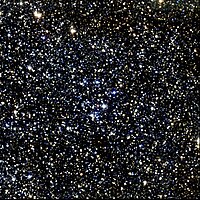 M18 photo from the w:2MASS project. | |
| Observation data (J2000.0 epoch) | |
| Right ascension | 18h 19.9m |
| Declination | −17° 08′ |
| Distance | 4.9 kly (1.5 kPc) |
| Apparent magnitude (V) | 7.5 |
| Apparent dimensions (V) | 9.0′ |
| Other designations | NGC 6613 |
Messier 18 or M18 (also designated NGC 6613) is an w:open cluster of w:stars in the w:constellation Sagittarius. It was discovered by w:Charles Messier in w:1764 and included in his list of w:comet-like objects. From the perspective of w:Earth, M18 is situated between the w:Omega Nebula (M17) and the w:Sagittarius Star Cloud (M24). Its age is estimated at 32 million years.
External links
M19
| Messier 19 | |
|---|---|
 | |
| Observation data (J2000 epoch) | |
| Class | VIII |
| Constellation | Ophiuchus |
| Right ascension | 17h 02m 37.69s[1] |
| Declination | -26° 16′ 04.6″[1] |
| Distance | 28.0 kly (8.6 kpc) |
| Apparent magnitude (V) | +7.47[1] |
| Apparent dimensions (V) | 17′.0 |
| Physical characteristics | |
| Mass | kg ( M) |
| Radius | 70 |
| Other designations | NGC 6273, GCl 52[1] |
Messier 19 or M19 (also designated NGC 6273) is a w:globular cluster in the w:constellation w:Ophiuchus. It was discovered by w:Charles Messier in w:1764 and added to his catalogue of w:comet-like objects that same year.
M19 is the most w:oblate of the known globular clusters. It is at a distance of about 28,000 w:light-years from the w:Solar System, and is quite near to the w:Galactic Center, at only about 5,200 light-years away.
External links
References
- ↑ a b c d "SIMBAD Astronomical Database". Results for NGC 6273. Retrieved 2006-11-16.

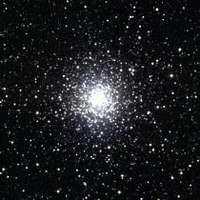
M20
| Trifid Nebula | |
|---|---|
 | |
| Observation data: w:J2000 epoch | |
| Type | Emission/Reflection |
| Right ascension | 18h 02m 23s[1] |
| Declination | -23° 01′ 48″[1] |
| Distance | 2000 - 9000 ly |
| Apparent magnitude (V) | +6.3[1] |
| Apparent dimensions (V) | ~20 arcmins |
| Constellation | Sagittarius |
| Physical characteristics | |
| Radius | - |
| Absolute magnitude (V) | - |
| Notable features | - |
| Other designations | M20, NGC 6514[1], Sharpless 30, RCW 147, Gum 76 |
The Trifid Nebula (catalogued as Messier 20 or M20 and as NGC 6514) is an w:H II region located in Sagittarius. Its name means 'divided into three lobes'. The object is an unusual combination of an w:open cluster of w:stars, an w:emission nebula (the lower, red portion), a w:reflection nebula (the upper, blue portion) and a w:dark nebula (the apparent 'gaps' within the emission nebula that cause the trifid appearance; these are also designated Barnard 85). Viewed through a small w:telescope, the Trifid Nebula is a bright and colorful object, and is thus a perennial favorite of amateur astronomers.
Characteristics
The Trifid Nebula was the subject of an investigation by astronomers using the w:Hubble Space Telescope in w:1997, using filters that isolate emission from w:hydrogen w:atoms, w:ionized w:sulfur atoms, and doubly ionized w:oxygen atoms. The images were combined into a false-color composite picture to suggest how the nebula might look to the eye.
The close-up images show a dense cloud of dust and gas, which is a w:stellar nursery full of embryonic stars. This cloud is about 8 w:light years away from the nebula's central star. A w:stellar jet protrudes from the head of the cloud and is about 0.75 w:light-years long. The jet's source is a young stellar object deep within the cloud. Jets are the exhaust gasses of star formation. Radiation from the nebula's central star makes the jet glow.
The images also showed a finger-like stalk to the right of the jet. It points from the head of the dense cloud directly toward the star that powers the Trifid nebula. This stalk is a prominent example of an w:evaporating gaseous globules, or 'EGGs'. The stalk has survived because its tip is a knot of gas that is dense enough to resist being eaten away by the powerful radiation from the star.
In January, 2005, w:NASA's w:Spitzer Space Telescope discovered 30 embryonic stars and 120 newborn stars not seen in w:visible light images.
Gallery
-
M20 Amateur Image Courtesy Hunter Wilson
-
The Trifid Nebula in infrared as seen by the Spitzer Space Telescope
-
Credit:Adam Block-Mount Lemmon SkyCenter. University of Arizona (Board of Regents)
External links
- Spitzer IR Trifid discoveries
- Messier 20, SEDS Messier pages
- Trifid Nebula at ESA/Hubble
References
- ↑ a b c d "SIMBAD Astronomical Database". Results for NGC 6514. Retrieved 2006-11-16.
M21
| Messier 21 | |
|---|---|
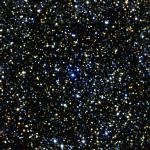 [ [ | |
| Observation data (J2000.0 epoch) | |
| Right ascension | 18h 04.6m |
| Declination | −22° 30′ |
| Distance | 4.25 kly (1.3 kPc) |
| Apparent magnitude (V) | 6.5 |
| Apparent dimensions (V) | 13.0′ |
| Other designations | NGC 6531 |
Messier 21 or M21 (also designated NGC 6531) is an w:open cluster of w:stars in the w:constellation of Sagittarius. It was discovered and catalogued by w:Charles Messier on w:June 5, w:1764.
M21 is a relatively young cluster of a mere 4.6 million w:years of age. It is tightly packed but contains about 57 w:stars. A few blue giant stars have been identified in the cluster, but Messier 21 is composed mainly of small dim stars. With a magnitude of 6.5, M21 is not visible to the naked eye; however, with the smallest binoculars it can be easily spotted on a dark night.
External links
M22
| Messier 22 | |
|---|---|
 Core of Messier 22 | |
| Observation data (w:J2000 epoch) | |
| Class | VII |
| Constellation | Sagittarius |
| Right ascension | 18h 36m 24.21s[1] |
| Declination | -23° 54′ 12.2″[1] |
| Distance | 10.6 ± 1.0 kly (3.3 ± 0.3 kpc[2]) |
| Apparent magnitude (V) | +6.17[1] |
| Apparent dimensions (V) | 32′.0 |
| Physical characteristics | |
| Mass | kg (105 to 106 M) |
| Radius | 50 ± 5 ly[3] |
| VHB | 14.2 |
| Estimated age | 12 Gyr[4] |
| Notable features | One of four globulars known to contain a planetary nebula. |
| Other designations | NGC 6656, GCl 99[1] |
Messier 22 (also known as M22 or NGC 6656) is an elliptical w:globular cluster in the w:constellation Sagittarius near the w:Galactic bulge region. It is one of the brightest globulars that is visible in the night sky.

History
M22 was one of the first globulars to be discovered in w:1665 by w:Abraham Ihle[2] and it was included in Charles Messier's catalog of w:comet-like objects on June 5, w:1764.
It was one of the first globular clusters to be carefully studied first by w:Harlow Shapley in w:1930. He discovered roughly 70,000 stars and found it had a dense core. [5] Then w:Halton Arp and w:William G. Melbourne continued studies in w:1959.[6] Because of the large color spread of its w:red giant branch (RGB) sequence, which is similar to that observed in w:Omega Centauri, it became the object of intense scrutiny starting in w:1977 with w:James E. Hesser et al.[7][2]
Characteristics
M22 is one of the nearer globular clusters to w:Earth at a distance of about 10,600 w:light-years away. It spans 32' on the sky which translates to a spatial diameter of 99 ± 9 light-years. 32 w:variable stars have been recorded in M22. It is projected in front of the galactic bulge and is therefore useful for its w:microlensing effect on the background stars in the bulge.[4]
Despite its relative proximity to us, this w:metal-poor cluster's light is limited by w:dust extinction, giving it an apparent magnitude of 5.5 making it the brightest globular cluster in the norther hemisphere.[8]
Planetary Nebula
M22 is very unusual in that it is one of only four globulars (the others being M15, w:NGC 6441 and w:Palomar 6) that are known to contain a w:planetary nebula (PN). It was discovered using the w:IRAS satellite by w:Fred Gillett et al.,in 1986 as a pointlike source (w:IRAS 18333-2357)[9] and subsequently identified as a PN in 1989 by Gillett et al.[10] The PN's central star is a blue star. The PN (designated w:GJJC1) is estimated to be a mere ~6,000 years old.[2]
External links
References
- ↑ a b c d "SIMBAD Astronomical Database". Results for NGC 6656. Retrieved 2006-11-15.
- ↑ a b c d Monaco, L.; Pancino, E.; Ferraro, F. R.; Bellazzini, M. (2004). "Wide-field photometry of the Galactic globular cluster M22". Monthly Notices of the Royal Astronomical Society. 349 (4): 1278–1290. doi:10.1111/j.1365-2966.2004.07599.x.
{{cite journal}}: CS1 maint: multiple names: authors list (link) - ↑ distance × sin( diameter_angle / 2 ) = 50 ly. radius
- ↑ a b Gaudi, B. Scott (2002). "Interpreting the M22 Spike Events". The Astrophysical Journal. 566 (1): 452–462. doi:10.1086/338041.
- ↑ Shapley, Harlow (1930). "The Mass-Spectrum Relation for Giant Stars in the Globular Cluster Messier 22". Harvard College Observatory Bulletin. 874: 4–9.
- ↑ Arp, H. C.; Melbourne, W. G. (1959). "Color-magnitude diagram for the globular cluster M22". The Astronomical Journal. 64: 28. doi:10.1086/107848.
{{cite journal}}: CS1 maint: multiple names: authors list (link) - ↑ Hesser, J. E.; Hartwick, F. D. A.; McClure, R. D. (1977). "Cyanogen strengths and ultraviolet excesses of evolved stars in 17 globular clusters from DDO photometry". Astrophys. J., Suppl. Ser. 33: 471. doi:10.1086/190438.
{{cite journal}}: CS1 maint: multiple names: authors list (link) - ↑ I. Ivans, C. Sneden, G. Wallerstein, R. P. Kraft, J. E. Norris, J. P. Fulbright, and G. Gonzalez (2004). "On the Question of a Metallicity Spread in Globular Cluster M22 (NGC 6656)" (PDF). Societa Astronomica Italiana. 75: 286.
{{cite journal}}: CS1 maint: multiple names: authors list (link) - ↑ Gillett, F. C.; Neugebauer, G.; Emerson, J. P.; Rice, W. L. (w:January 15 w:1986). "IRAS 18333-2357 - an unusual source in M22". Astrophysical Journal, Part 1 (ISSN 0004-637X), w:NASA-supported research. 300: 722–728. doi:10.1086/163846.
{{cite journal}}: Check date values in:|date=(help)CS1 maint: multiple names: authors list (link) - ↑ Cohen, J. G.; Gillett, F. C. (w:November 15 w:1989). "The peculiar planetary nebula in M22". Astrophysical Journal, Part 1 (ISSN 0004-637X), Research supported by w:California Institute of Technology. 346: 803–807. doi:10.1086/168061.
{{cite journal}}: Check date values in:|date=(help)CS1 maint: multiple names: authors list (link)
M23
| Messier 23 | |
|---|---|
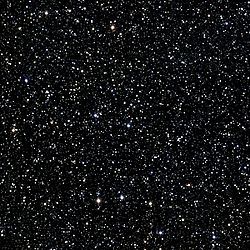 | |
| Observation data (w:J2000 epoch) | |
| Constellation | Sagittarius |
| Right ascension | 17h 56.8m |
| Declination | −19° 01′ |
| Distance | 2.15 kly (659 Pc) |
| Apparent magnitude (V) | 6.9 |
| Apparent dimensions (V) | 27.0′ |
| Other designations | NGC 6494 |
Messier 23 (also known as NGC 6494) is an w:open cluster in the w:constellation Sagittarius. It was discovered by w:Charles Messier on w:June 20, w:1764.
M23 is at a distance of about 2,150 w:light-years away from w:Earth, its radius is around 15-20 w:light years. There are some 150 identified members in this cluster, the brightest being of magnitude 9.2. M23 can be found with a modestly sized w:telescope in the rich starfields of the Sagittarius w:Milky Way.
External links
M24

The Sagittarius Star Cloud (also known as Delle Caustiche, Messier 24, IC 4715) is a w:star cloud in the w:constellation of Sagittarius, approximately 600 w:light years wide, which was discovered by w:Charles Messier in 1764.
The stars, clusters and other objects comprising M24 are part of the Sagittarius or Sagittarius-Carina arms of the w:Milky Way galaxy. Messier described M24 as a "large nebulosity containing many stars" and gave its dimensions as being some 1.5° across, a description that fits the star cloud rather well. Some sources, improperly, identify M24 as the faint cluster w:NGC 6603.
M24 fills a space of significant volume to a depth of 10,000 to 16,000 w:light-years. This is the most dense concentration of individual stars visible using w:binoculars, with around 1,000 stars visible within a single w:field of view.
External links
M25
| Messier 25 | |
|---|---|
 Sketch of the cluster Sketch of the cluster | |
| Observation data (J2000.0 epoch) | |
| Right ascension | 18h 31.6m |
| Declination | −19° 15′ |
| Distance | 2.0 kly (613 Pc) |
| Apparent magnitude (V) | 4.6 |
| Apparent dimensions (V) | 32.0′ |
| Other designations | IC 4725 |
Open Cluster M25 (also known as Messier Object 25 or IC 4725) is an w:open cluster in the w:constellation Sagittarius. It was discovered by w:Philippe Loys de Chéseaux in w:1745 and included in w:Charles Messier's list in w:1764.
M25 is at a distance of about 2,000 w:light-years away from w:Earth. The spatial dimension of this cluster is about 19 w:light years across. A Delta Cephei type w:variable star designated U Sagittarii is a member of this cluster.
